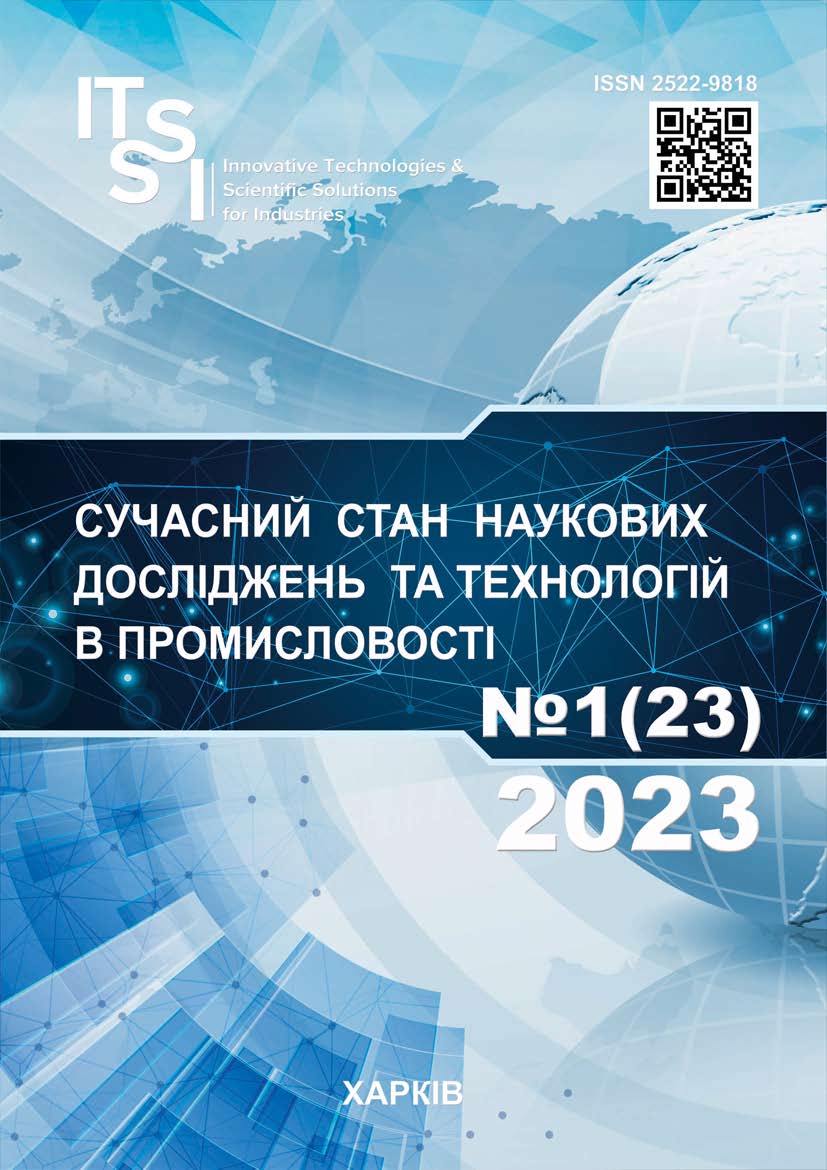ECONOMIC-MATHEMATICAL MODEL OF FORMATION OF INNOVATION AND ENGINEERING INDUSTRIAL CLUSTER
DOI:
https://doi.org/10.30837/ITSSI.2023.23.005Keywords:
innovation-engineering industrial cluster, synergistic regional effect, factor analysis, cluster analysisAbstract
The subject of the article is the use of industrial clusters as tools for innovative economic growth. The purpose of the article is to develop an economic-mathematical model of the formation of an industrial cluster, and to create an algorithm for cluster zoning of the economy. Tasks to be solved – analysis of the principles of innovative growth, development of a model of an innovation-engineering industrial cluster, formulation of a methodology for the formation of a regional innovation-engineering cluster, analysis and assessment of the features that arise in clusters, use of cluster analysis for systematization, classification and reduction of the number of features. Applied methods: system analysis, project approach, institutional theory, clustering methods, Bartlett’s sphericity criterion and Kaiser–Meyer–Olkin sampling adequacy criterion, multivariate regression analysis, Fisher’s F-test. The results obtained: it was determined that the best approach to unification of the main components of innovative development, namely state bodies, business and development institutes, is the creation of innovation and engineering clusters. The principles of creation and functioning of such clusters are described. It is shown that the basis of the cluster construction algorithm of regions is the integration of quantitative and qualitative methods of identification and clustering of the economy. This makes it possible, in contrast to existing approaches, not only to identify cluster elements, but also to model the levels of interaction between them. It is proposed to use the synergistic effect from the use of the newly formed structure as an assessment of the efficiency of the cluster. Conclusions: the use of regional innovation and engineering clusters allows for the formation of an effective strategy for the development of the region’s economy. The developed algorithm of cluster zoning integrates quantitative and qualitative methods of determining the clustering possibilities of the region’s economy. The complex interaction of economic and political factors leads to a synergistic effect and allows modeling cluster formation with the identification of the composition of participants and the level of interaction between them.
References
References
Shevchuk, S. (2011). Definition of the concept of innovative economy. Formation of market relations in Ukraine. 2011. No. 1. P. 83–86. URL: http://nbuv.gov.ua/UJRN/frvu_2011_1_21
Balanchuk, I.S., Mykhalchenkova, O.E. (2021). Technological platforms in the sphere of innovations – trends in Europe and Ukraine. Science, technologies, innovations. Р. 14–24. DOI: http://doi.org/10.35668/2520-6524-2021-2-03
Fedirko O.A. (2015). European technological platforms as a mechanism of sectoral innovative development of the EU / Scientific Bulletin of the International Humanitarian University. URL: https://ir.kneu.edu.ua/bitstream/handle/2010/33371/Nvmgu_eim_2015_14_10.pdf
Voynarenko M. (2014). Clusters in the economy of Ukraine: monograph / Khmelnytskyi: KNU. 1085 р.
Jolliffe I.T. (2002) Principal Component Analysis, Series: Springer Series in Statistics, 2nd ed., Springer, NY, XXIX. 487 p. URL: http://cda.psych.uiuc.edu/statistical_learning_course/Jolliffe%20I.%20Principal%20Component%20Analysis%20(2ed.,%20Springer,%202002)(518s)_MVsa_.pdf
Akhiezer E.B. (1996). The calculation of correlation matrices of some random processes. Materials of international scientific-technical conference "Information ion technology: science, engineering, technology, education, health". – Kharkov. P. 15–17.
Zhernova P., Bodyanskiy Ye. (2018). Kernel fuzzy clustering of data streams based on the ensemble of neural networks. Innovative technologies and scientific solutions for industries. – № 4 (6). P. 50–56. DOI: https://doi.org/10.30837/
-9818.2018.6.042
Ryneiska L. S. Klastery u suchasnii hlobalnii ekonomitsi [Clusters in today’s global economy]. URL: http://www.economy.nayka.com.ua
Kor
obova M., Lyashenko I., Stolyar A. (2006). Fundamentals of mathematical modeling of economic, ecological and social processes / Educational book – Bohdan, 304 р. URL: https://book-ye.com.ua/upload/iblock/7d4/c7fbefb1_dca3_11e6_80c1_000c29ae1566_b5448ce9_873d_11e7_80cf_000c29ae1566.pdf
Reshetnyak, O. (2020). Modeling rating of scientific and technological development of the countries. Innovative technologies and scientific solutions for industries. – 2020. № 1 (11). Р. 80–89. DOI: https://doi.org/10.30837/2522-9818.2020.11.080
Pryimak V. (2019). Mathematical methods of economic analysis // K. Center of educational literature. 296 р.
Dunaevskaya I. (2008). Multistage clustering in the traveling salesman problem of high dimension / O.V. Gray, I. Dunaevskaya // East European journal of advanced technologies. No. 5/5. P. 54–56.
Kostenko U. T., Ruskin L. G. (1996). Forecasting technical condition control systems. – Kharkov: The Foundation. 303 p.
Ivakhnenko A. G. (1975) Long-term prediction and control of complex systems. – Kyiv: Tekhnika. 311 p.
Bibik N., Shapoval G. (2019) An analysis of international experience of the development of territorial communities and the determination of the directions of its implementation in Ukraine. Innovative technologies and scientific solutions for industries, № 2 (8).
Р. 5–71. DOI: https://doi.org/10.30837/2522-9818.2019.8.005
Downloads
Published
How to Cite
Issue
Section
License
Copyright (c) 2023 Олена Ахієзер , Ольга Дунаєвська , Антон Роговий , Галина Голотайстрова , Юрій Решетняк , Сергій Мехович

This work is licensed under a Creative Commons Attribution-NonCommercial-ShareAlike 4.0 International License.
Our journal abides by the Creative Commons copyright rights and permissions for open access journals.
Authors who publish with this journal agree to the following terms:
Authors hold the copyright without restrictions and grant the journal right of first publication with the work simultaneously licensed under a Creative Commons Attribution-NonCommercial-ShareAlike 4.0 International License (CC BY-NC-SA 4.0) that allows others to share the work with an acknowledgment of the work's authorship and initial publication in this journal.
Authors are able to enter into separate, additional contractual arrangements for the non-commercial and non-exclusive distribution of the journal's published version of the work (e.g., post it to an institutional repository or publish it in a book), with an acknowledgment of its initial publication in this journal.
Authors are permitted and encouraged to post their published work online (e.g., in institutional repositories or on their website) as it can lead to productive exchanges, as well as earlier and greater citation of published work.














